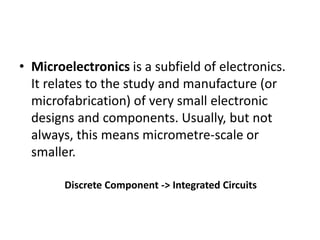Microelectronics involves the study and fabrication of very small electronic components, usually on the micrometer scale. The document discusses the evolution from discrete components to integrated circuits and the advantages of integrated circuits. It describes the basic process of integrated circuit fabrication including wafer preparation, epitaxial growth, oxidation, photolithography, diffusion, metallization, testing, dicing, packaging, and encapsulation. Key steps like Czochralski growth, oxidation, lithography, and diffusion are explained in more detail.












































